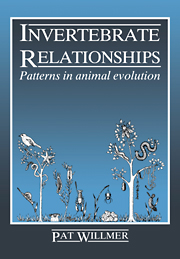Book contents
- Frontmatter
- Contents
- Acknowledgements
- Part I Introduction to animal phylogeny
- Part II Sources of evidence in invertebrate phylogeny
- Part III Phylogeny of major groups
- 7 The origin of the Metazoa
- 8 Acoelomates and other lowly worms
- 9 The pseudocoelomates
- 10 The phylogenetic position of molluscs
- 11 Arthropod phylogeny
- 12 The deuterostomes
- 13 The lophophorates
- 14 A phylogenetic overview of invertebrates
- References
- Index
8 - Acoelomates and other lowly worms
Published online by Cambridge University Press: 08 January 2010
- Frontmatter
- Contents
- Acknowledgements
- Part I Introduction to animal phylogeny
- Part II Sources of evidence in invertebrate phylogeny
- Part III Phylogeny of major groups
- 7 The origin of the Metazoa
- 8 Acoelomates and other lowly worms
- 9 The pseudocoelomates
- 10 The phylogenetic position of molluscs
- 11 Arthropod phylogeny
- 12 The deuterostomes
- 13 The lophophorates
- 14 A phylogenetic overview of invertebrates
- References
- Index
Summary
Introduction
In the preceding chapter, some attempt was made to decide where the first metazoan animals came from and what they might have been like. The most plausible answer takes as a starting point a planula/acoeloid form, small, ovoid and ciliated. As discussed in section 7.4, this can give rise both to the cnidarians, which have a planula larva, and to the bilateral acoelomate worms. It also provides a sensible starting point for radiations of pseudocoelomate and coelomate phyla, as the rest of this book should make clear. In effect, the planula can be seen as the early worm, and most of the designs it gave rise to are also elaborations on the theme of being a worm. This chapter deals with a subset of these variations on a theme: the worms that are conventionally regarded as part of the protostome or spiralian assemblage. All are supposed to share the classical patterns of spiralian development set out in chapter 5, so that in comparing them it should also be possible to get a perspective on the Protostomia/Spiralia super-phylum as a whole.
Acoelomate worms
Platyhelmnths
Apart from a predominantly German school of thought requiring flatworms and most other simple worms to be secondarily reduced from a coelomate state, the majority of currently popular theories suggest that flatworms are direct derivatives from the planuloid/acoeloid form. This early metazoan is assumed to settle to a benthic lifestyle, thereby acquiring greater bilaterality in association with moving directionally in two dimensions, and the beginnings of a proper gut as the tissues differentiate fully into three cell layers.
- Type
- Chapter
- Information
- Invertebrate RelationshipsPatterns in Animal Evolution, pp. 199 - 224Publisher: Cambridge University PressPrint publication year: 1990
- 2
- Cited by



